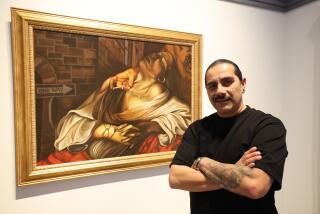Prison Artist Rose From the Needle to Needlepoint
- Share via
SOMERS, Conn. — The hypodermic needle and the bottle helped put Raymond Materson in Somers State Prison. Now a needle and thread are helping him survive behind bars.
Using unraveled socks for thread and the top of a plastic jar as an improvised embroidery hoop, Materson creates brightly colored tapestries, few larger than the palm of one’s hand.
His art has come a long way from the sports logos and Harley-Davidson emblems that were his first attempts at embroidery. Galleries have exhibited some of his recent works, and the Museum of International Folk Art in Santa Fe, N.M., has purchased three of them.
Materson, 37, says he isn’t bothered by remarks about the time he spends sewing in his cell.
“I know that people say, ‘What’s that guy doing in there?’ but I don’t mind being alone,” he said.
“I believe we all have a drive to create and to do and to build, and if it’s not nurtured, then the exact opposite happens. People don’t create anymore. They stagnate and learn to destroy, and sometimes they destroy themselves.”
Materson took up needlework almost by accident, shortly after he began serving 15 years for kidnaping in 1988. What began as a hobby has become a vocation.
A college graduate with a degree in philosophy and performing arts, Materson was once a promising actor in community theater. He often pays homage to the theater in his tapestries.
There are scenes from “Hamlet,” and from Anton Chekhov’s “The Three Sisters,” as well as a portrait of Scarlett O’Hara in the opening scene of “Gone with the Wind.”
But imaginary worlds are not the only inspiration for the exquisitely detailed miniature tapestries, which Materson describes as “like painting with thread.”
Some of his works are historical, such as the series on American soldiers in the Vietnam War. Some are autobiographical, such as the lakeside landscapes that evoke his youth in Michigan.
Some of his works pay homage to other artists. There are tiny, embroidered copies of paintings by Marc Chagall and Claude Monet.
The maximum-security prison’s strict regulations force Materson to be resourceful in finding materials. He sews his designs onto cotton from boxer shorts--sent in by his mother--and frames each tapestry with black shoelace thread.
Nail clippers serve as scissors, and sometimes fellow inmates donate T-shirts to be used for cloth borders.
Materson, whose long hair and piercing gaze give him a haunted look, said he was falling apart when he arrived at Somers. His wife had refused to live with an addict and had left him a few years before, taking their small daughter with her. He had tried and failed to stop using cocaine and drinking and was finding himself more and more out of control.
When his sister suggested that he leave Michigan for Connecticut, where she was living, he jumped at the chance to escape, but in Connecticut things just got worse. He was trying to get money for drugs when he was arrested.
“At first it was just a drink after work. . .and the next thing I knew, I’d gone back to the syringe,” Materson said.
His needlework has been therapeutic, he said.
“It was like I was guided. There was something providential about it,” he said, “because, every time someone asked me to do a piece for them it got just a little more involved but each time, I could do it.”
More to Read
The biggest entertainment stories
Get our big stories about Hollywood, film, television, music, arts, culture and more right in your inbox as soon as they publish.
You may occasionally receive promotional content from the Los Angeles Times.











